- "The Hidden Blade has been a constant companion of ours over the years. Some would say it defines us – and they would not be entirely wrong. Many of our successes would not have been possible without it."
- ―Altaïr Ibn-La'Ahad's Codex, page 13.[src]
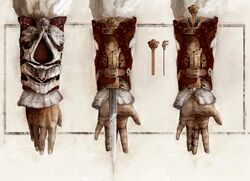
Front and back of the Hidden Blade; extended (center) and retracted (right)
The Hidden Blade is the signature weapon of the members of the Assassin Brotherhood, designed as their primary means of enacting assassinations. Consisting of a blade that can be discreetly extended or retracted from a bracer or gauntlet, the Hidden Blade's portability and concealability complement the Assassins' trademark affinity for stealth and freerunning. It allowed an Assassin to eliminate a target while drawing virtually no attention to themselves, and the techniques developed for its use often ensure near-instantaneous death.
Aside from its practical applications, the blade possesses a ceremonial status that owes to its long history, dating back to at least the Achaemenid Empire when the Assassin Darius used the blade to kill the Persian king Xerxes I of Persia. The blade later travelled to Egypt with Darius, after which its fate is unknown. In the first century A.D. it was given to Aya by Cleopatra. Later Bayek was given the original blade by Aya, afterwards Aya made herself a replica. Bayek cemented it as the signature weapon of the Hidden Ones, and through them, the Assassin Brotherhood.[1] Since then, the Hidden Blade has continued to evolve throughout the millennia.
Originally requiring the removal of a ring finger to facilitate the extension of the blade, the weapon was modified during the Mentorship of Altaïr Ibn-La'Ahad so that such a sacrifice was no longer necessary. Further modifications were carried out by various branches of the Brotherhood in subsequent centuries, often by individual users seeking to adapt it to their personal styles. Such examples include the Hidden Footblade of Shao Jun;[2] the Pivot Blade of Ratonhnhaké:ton;[3] the Trident Blade of Arbaaz Mir;[4] and most recently, the Shock Blade of modern times.[5]
Design
- "The blade is designed to ensure the commitment of whoever wields it."
- ―Leonardo da Vinci, regarding the Hidden Blade.[src]

Ezio Auditore with his father's Hidden Blade
As its name implies, the Hidden Blade is a concealable weapon that is composed of a narrow blade set into a channel on the underside of a bracer or gauntlet. Controlled by a spring-loaded mechanism, the blade can spontaneously extend and retract from its position.[6][7][8][9] While this mechanism has differed between models over the centuries,[8][10][11][12] the one in use by the early Levantine Brotherhood employed a ring looped around the little finger and tied to the blade. This ring, when tugged by extending the finger alongside a simultaneous flicking of the wrist, activated the mechanism and unleashed the blade.[8][10]
The use of the Hidden Blade initially required the amputation of a ring finger as a means of allowing the blade to be extended should the user clench their fist, but this is not to say that the blade itself was inoperable without the sacrifice, as both Bayek and Layla Hassan were capable of using the blade simply by flicking their wrists.[8] As the blade's size allowed it to fit neatly through the resulting gap,[6] when an Assassin clenched their fist, the weapon essentially functioned as an extension of the Assassin's own spirit and body—a literal replacement for the lost finger.[8] In this way, the sacrifice demanded with the use of the Hidden Blade was meant to demonstrate the absolute commitment of the one wielding it.[6][7][8] This custom first began when Bayek of Siwa accidentally severed his ring finger when he killed Eudoros, the Hippo of the Order of the Ancients.[13]
Nevertheless, the custom proved to be a handicap as the early Levantine Assassins could be recognized by their missing fingers.[14] To rectify this, the blade's mechanism was modified in the 13th century[9] by the Levantine Mentor Altaïr Ibn-la'Ahad—as outlined in his Codex—so as to no longer require such an extreme sacrifice, and to keep Assassins from being identified so easily.[7] Instead, from the time of this reform to at least the early 20th century,[15] many Assassins branches branded their left ring finger during their initiation into the Order as a sign of their devotion to their cause.[7][16] Other Assassins opted for a tattoo on their ring finger instead while still more traditional-minded guilds such as the Spanish Brotherhood retained the ritual of severing their fingers even when it was no longer necessary.[8][17]
The redesign overhauled the trigger mechanism as well, such that from then on, the blade was launched not by pulling at a ring on the little finger, but by a pressure switch inside the bracer itself. As with the former mechanism, flexing of the wrist remains the means of activation though the little finger is no longer involved in the process.[8][11]
Components
With the aid of the Apple of Eden, Altaïr re-discovered a lost formula for a secret alloy utilized by the ancient Isu. Under his leadership, Hidden Blades were forged from this metal.[7][8] Because the metals for this alloy were scarce, the Mentor had to be mindful of the supply of Hidden Blades. By the end of his life, his fear that the alloy would be stolen and appropriated by nefarious forces led him to erase all records of its formula entirely. As a result, he took this secret to his death.[7][14] Hidden Blades afterwards reverted back to employing lesser, common metals, such as iron, for its blade.[15]
The standard model of Hidden Blade crafted by the Italian Brotherhood during the Renaissance era was constructed from a bar of iron and at least two coils; three gears, two sprockets, one chain, and three screws alongside the hide for the leather bracer.[15]
Fragility and metal deflection plate
Due to their small size, Hidden Blades could be broken when struck with enough force and were not originally designed for full-fledged combat.[6] Although the use of Isu metal by Altaïr temporarily eliminated this flaw, not all Assassins had the luxury of accessing Hidden Blades forged from this alloy. Several Assassins after him at some point in their lives, including Giovanni Auditore da Firenze and his son Ezio of the Italian Brotherhood, had their blades broken in combat under the blow of a sword.[14][18] In 1715; the blade of the Assassin traitor Duncan Walpole was bent out of shape in the midst of combat with the pirate Edward Kenway, rendering it unusable.[19] This fragility persists in modern times; in 2015, Master Assassin Galina Voronina had both of her Hidden Blades broken in combat with Juhani Otso Berg when the blades got stuck in a pillar when she tried to stab him, and he punched her arms, snapping the blades off in the process.[5]
As a result, Assassins throughout history typically favoured more conventional weapons such as swords in open conflict, with Hidden Blades only relegated to assassinations.[6] Their short length—with a lesser reach than that of daggers—meant that without upgrades, they were unsuited for parrying. In his modifications, Altaïr added a plate forged from Precursor metal to act as reinforced barriers for the bracer.[7] As demonstrated by Ezio, this near-indestructible plate was highly effective at deflecting the strikes of other weapons.[7][16] In spite of its efficiency, this innovation was not ubiquitous, unlike the redesign that removed the necessity of severing the ring finger. As late as the 18th and 19th centuries, Assassins from the Parisian Brotherhood and British Brotherhood could not feasibly utilize Hidden Blades in combat.[5][20]
History
Early use
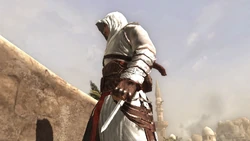
Altaïr with his Hidden Blade extended
The first recorded use of the Hidden Blade was dated during the 5th century BCE, in the area known as modern-day Iran, when Darius used it to assassinate King Xerxes I.[7][21] The Hidden Blade's history of use was extended further in Egypt during the Ptolemaic Kingdom when Darius' Hidden Blade was given to his descendant Aya by Cleopatra to aid in their quest to take down the Order of the Ancients; Aya in turn later gave it to her husband, Bayek. It was the accidental severing of Bayek's ring finger that began the custom of removing said finger.[13]
During the 9th century, the Viking Eivor possessed a Hidden Blade which, like Darius’, had the blade on top of the wrist, rather than below it albeit over their left forearm rather than their right.[22]
By the 12th century, Assassins were regularly outfitted with a Hidden Blade as part of their equipment. The blades saw a wide and extensive use for assassinations, as they could be easily kept out of sight and allowed for quicker and stealthier eliminations.[6]
Following his rise to the position of Mentor of the Levantine Brotherhood in 1191, Altaïr Ibn-La'Ahad was inspired by the Apple of Eden to redesign the Hidden Blades so that they could be used without the removal of the ring finger. A construction that became common thereafter.[7]
Advancements in design
- "Despite its age, the construction is rather advanced. I've never seen anything quite like it."
- ―Leonardo da Vinci studying the Hidden Blade.[src]
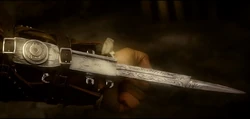
Giovanni Auditore's Hidden Blade
By the 15th century, the updated Hidden Blade design was dispersed throughout the Old World. The mechanism no longer required a wrist "flick" to release the blade, allowing the user to extend or retract it without any hand movement. Additionally, the weapon could be used with a clenched fist; Giovanni Auditore was one of the few known Assassins to use it in this manner.[18]
Through studying pages from Altaïr's codex, Leonardo da Vinci was able to provide Ezio Auditore with a variety of upgrades, such as the addition of a second Hidden Blade. The right to bear two Hidden Blades was thereafter reserved for those who had earned the rank of Master Assassin.[7] Later innovations to the weapon's design included: a hook, most common to the Ottoman Assassins of Constantinople,[14]; extra blades, as seen among the Indian Assassins,[4]; and the hidden foot blade, utilized by the Chinese Assassin Shao Jun.[2]
By the 17th century, use of dual blades had become more common, as suggested by a large number of such weapons collected by Julien du Casse. Slight structural changes had also emerged; as the blades used by the Caribbean Assassins, and the Colonial Assassins prior to the purge in 1763, were wider than those seen in 16th century Europe.[19] At an unknown point in time, former Mentor of the Colonial Assassins, Achilles Davenport, acquired a Hidden Blade which could pivot and be used in a manner similar to a dagger. He passed this blade on to Ratonhnhaké:ton in 1770, who often wielded it in conjunction with his tomahawk.[23] In the mid 19th century, the Indian Assassin Arbaaz Mir utilized a Hidden Blade in the form of a trident, composed of three blades.[4]
Modern times
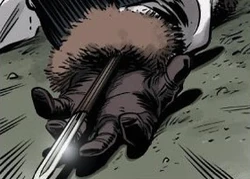
Nikolai Orelov's Hidden Blade
During the late 19th and early 20th century, the Hidden Blade was still a part of standard Assassin attire and continued to be commonly used in close combat. However, they began to decline in usage shortly after and were retained largely only by high-ranking Assassins, such as Paul Bellamy, for purposes of tradition. They were also used as part of ceremonies, such as when Daniel Cross was gifted with a Hidden Blade by the Mentor in 2000.[24]
Regular use of the Hidden Blade, while uncommon in the 21st century, is still practised in some regions. In 2013, members of the Onmoraki-Gumi, a Yakuza branch taken over by the Japanese Brotherhood in Osaka, wore Hidden Blades that were concealed by the long sleeves of their suits.[25]
By the 21st century, the Indians once again used a new design of this iconic weapon, one that incorporated an explosive device. This mechanism could be remotely activated by a touch screen on another wirelessly connected Hidden Blade and served as a means to dispose of the body of a fallen comrade. When Jasdip Dhami activated the weapon of his dead sister in 2013, the explosion was so powerful that it destroyed an entire floor of a building. Aside from this, this particular model shifted the blade to the side, defying the usual custom of hiding it beneath the wrist.[4]
Combat
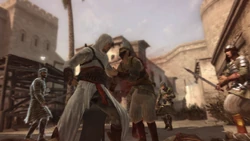
Altaïr performing a counter with the Hidden Blade
As its main purpose was for stealthy assassinations, the Hidden Blade could only be used in combat under certain conditions, and could not block any attack. Altaïr was only able to assassinate a guard who had fallen to the ground or become inattentive.[6]Altaïr could also use the Hidden Blade in a counterattack; however, the time frame was extremely short in comparison to that of his sword and dagger. Successfully intercepting an attack enabled one of several different – and always lethal – counterattacks.[6]
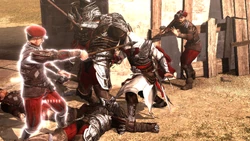
Ezio using his dual blades in combat
The Hidden Blade became more useful in combat due to upgrades over time. The mounting of a metal plate on the opposite side of the blade allowed it to be used defensively. In terms of an offense; when used together, the dual Hidden Blades were swift but less damaging in comparison to a sword, with more utility in suppressing enemy attacks. In addition; every counterattack with the Hidden Blades resulted in an instant kill, with only the narrow timing window as a disadvantage.[7]
Other users
Despite it being their primary and most recognizable feature, the Hidden Blade's use has not always been exclusive to the Assassins, with some even falling into the hands of the Templar Order. Several Assassins who betrayed their order and joined the Templars were known to keep their Hidden Blades rather than dispose of them, understanding their usefulness. Vali cel Tradat[14] and Shay Cormac were both examples of this, and both actively used them to hunt down and kill many of their former brothers and sisters.[26] Other Templars were known to take Hidden Blades as trophies from Assassins they had encountered; Haytham Kenway[23] and Julien du Casse[19] were examples, with Kenway's left Hidden Blade being taken from the British Assassin Miko after a duel[27] and later being taken in turn by his son Ratonhnhaké:ton as a memento.[23] Daniel Cross also possessed a Hidden Blade which he was given by the Mentor of the Assassin Order and which Daniel used to kill the Mentor immediately afterwards;[24] he then turned this blade over to his superiors at Abstergo, who studied and heavily modified the original design.[28] Finally, the Templar Julie de la Serre used a blade hidden under her shoe.[29]
Upgrades and adaptations
Modifications by Altaïr Ibn-La'Ahad
- "The device has begun to show its age – and so I have been researching improvements beyond ending the need to remove one's finger to wield it."
- ―Altaïr Ibn-La'Ahad's Codex, page 13.[src]
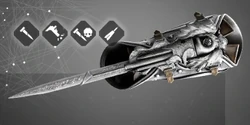
The blade with the pistol and poison upgrades
In his studies of the Apple of Eden, Altaïr envisioned several upgrades for the Hidden Blade which he recorded in his Codex,[7] and which were implemented under his Mentorship.[14] Centuries later Ezio acquired these Codex pages over his travels, and Leonardo da Vinci recreated the improvements detailed within when Ezio presented him with a page.[7]
The first of these improvements was the provision of a metal plate on top of the primary blade's bracer. This allowed one to safely deflect enemy attacks with the blades and also made the blade more durable in combat. Most critically, the entire weapon was redesigned so as to eliminate the necessity of removing the ring finger for an extension. The third yet most simple was the provision of a secondary Hidden Blade; attached to the user's other arm and identical in every way to the first, allowing an Assassin to kill two targets, one beside the other, at once, whether on the ground or from the air.[7]
Poison Blade
- Main article: Poison Blade
In a break from the prohibitions of his predecessor Al Mualim, Altaïr created the Poison Blade, a supplement to the Hidden Blade that is hollowed within to harbour poison that was injected when the blade was stabbed into a target. Because of its exceedingly thin profile and the requirement of a hollow chamber, the Poison Blade risked being particularly brittle, and in his Codex, Altaïr cautioned that deviations from his exact schematics would likely produce a blade that could easily fracture. Intended as an even less conspicuous weapon, the Poison Blade was not designed for high-profile assassinations, but to silently prick enemies and leave them to die slow deaths that occasionally serve as diversions for other enemies.[7]
Hidden Gun
- Main article: Hidden Gun
An invention that was far ahead of its time, the Hidden Gun was a portable firearm built into the Hidden Blade's bracer which acted as a ranged counterpart to the usual blade. While its ammunition were shots typical of the pistols that were standard until the end of the early 19th century, its wheellock mechanism was far more sophisticated than the flintlocks of later centuries. Unlike later ranged variants, the Hidden Gun was as loud and disruptive as any typical firearm and emitted a cloud of smoke upon firing and consequently was not ideal for stealth; when Ezio used it to assassinate the Templar Marco Barbarigo, he timed his firing with the explosion of fireworks at the Carnevale to disguise the noise. Nevertheless, as a concealed, ranged weapon, it was an effective and deadly tool for surprise assassinations, discreet up until the instant after its execution.[7] The first recorded victim of the Hidden Gun was, however, Abbas Sofian, as Altaïr shot him in 1247.[14]
Poison dart launcher
- Main article: Poison dart
The Italian polymath Leonardo da Vinci, as one of the closest friends to Ezio Auditore, was a chief engineer and inventor for the Italian Brotherhood; and, using the blueprints found in Altaïr's Codex, he implemented further improvements to the Hidden Blade. During his time in Rome; he crafted a ranged-variant of the Poison Blade, a poison dart launcher, which fired poison darts from a distance.[16]
Hidden Bolt
- "I ask if he can arm a crossbow bolt beneath my wrist. He ponders for a moment and declares it possible, but expensive."
- ―Francesco Vecellio asking Leonardo to create the Hidden Bolt.[src]
At the request of the Italian Assassin apprentice Francesco Vecellio, Leonardo designed the Hidden Bolt, a weapon that could fire small crossbow bolts. As Francesco was only an apprentice at the time, Ezio had not allowed him to use the Hidden Gun, and so Francesco had devised a similar, though lighter, alternative.[15] As a portable miniature wrist-mounted crossbow, the Hidden Bolt was a precursor-of-sorts to the later Phantom Blade used by the French brotherhood in 18th century.[20]
Two-pronged Blade
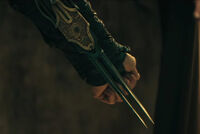
María's hidden blade
During the Spanish Inquisition, the Spanish Assassin María used a variation of the Hidden Blade which consisted of two thinner blades positioned next to one another. Besides this modification, the weapon operated similarly to the traditional Hidden Blade.[17] Its template, as a two-pronged Hidden Blade, was later adopted in the 21st century as the basis for the Shock Blade.[8]
Hook blade
- Main article: Hookblade
- "The Hookblade helps you get around fast, surprise guards, and is not too bad in a fight."
- ―Yusuf Tazim to Ezio Auditore da Firenze[src]
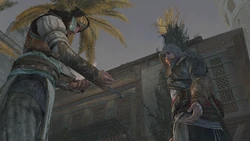
Yusuf showing the Hookblade to Ezio
The Hookblade was a modification of the Hidden Blade that was first adopted by the Ottoman Brotherhood of Assassins. Unlike the other Hidden Blade advancements, it was attached to the user's secondary Hidden Blade instead of the primary. It consisted of both a curved hook and a regular blade, allowing it to be used for freerunning as well as combat.[14]
Upon his arrival in the city of Constantinople, Ezio was introduced to this advancement by Yusuf Tazim, who instructed the former in its application in both navigation and combat. With regard to the former, the Hookblade extended one's reach while climbing and leaping and could be used in conjunction with ziplines that had been installed throughout Constantinople. Additionally, it allowed the wielder to perform the "hook-and-run", a manoeuvre in which the wielder flipped over enemies to pass them by.[14]
The Hookblade also aided in battle by allowing a wider variety of attacks or counters, such as the "hook-and-throw", which pulled in targets for a close-range attack. In addition, it permitted one to "counter-steal", essentially tearing off an enemy's purse with the blade, which provoked them further and left them open to an easy counterattack.[14]
Aside from this, the Hookblade could be used to pull down scaffolds while on the run, thereby slowing down or eliminating pursuers. This was particularly useful when done in conjunction with caltrop bombs.[14]
Hidden Footblade
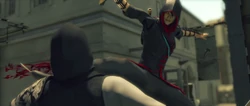
Jun utilizing her Hidden Footblade in melee combat
Also referred to as the Hidden Shoe Blade, the Hidden Footblade was a modification made to the Hidden Blade by Chinese Assassin Shao Jun. It allowed its users to maintain a low profile in areas where weapons were deemed restricted; as well as to surprise unsuspecting assailants with the combined use of blade and footwork, typically augmented through the studied use of leg-based martial arts. Shao Jun developed skilled footwork and flexibility because she danced in the imperial court when she was a concubine for the Zhengde Emperor, who refused to bind her feet. It was one of her favourite methods of assassination.[2][30]
However, this tactic was not solely exclusive to the Assassin Order: Julie de la Serre, a French Templar and wife to Grand Master François de la Serre, implemented the use of a Hidden Footblade in combat with two rogue Assassins who had been employed to eliminate her and her daughter Élise.[29]
Pivot Blade
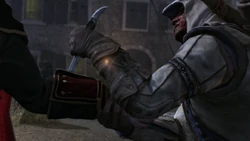
Ratonhnhaké:ton stabbing Haytham Kenway with the Pivot Blade
By the 18th century, the Hidden Blade had become an even deadlier tool, thanks to the development of the Pivot Blade, which allowed its user to rotate the blade 90 degrees and wield it like a dagger. It could be held either in a hammer or icepick grip; allowing Assassins such as Ratonhnhaké:ton to quickly stab, cut, and slash their enemies. It could also be dual-wielded alongside a sword, dagger, or a tomahawk, allowing defensive parries and fierce counterattacks.[23]
The Pivot Blade could then be retracted into the Hidden Blade configuration for stealthy assassinations. When Ratonhnhaké:ton hunted wildlife in the wilderness, the Pivot Blade also made the task of skinning less tedious than it would have been with a normal Hidden Blade, since the blade was double-edged with one side serrated. This Hidden Blade could not be broken with an axe, due to its hardness, strength, and flexibility.[23]
Phantom Blade
- Main article: Phantom Blade
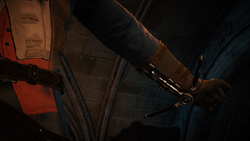
Arno's Phantom Blade
The Phantom Blade was a variation of the traditional Hidden Blade utilized by the French Assassins during the French Revolution; taking inspiration from crossbows to condense one into a wrist-mounted form, making it both fast and deadly at long range. The Phantom Blade could be loaded with a projectile blade or a poisoned blade that caused the victim to attack others, allowing Assassins like Arno Dorian a silent kill or distraction, with room for further refinement through the firing mechanism to allow two shots per reload.[20]
Trident Blade
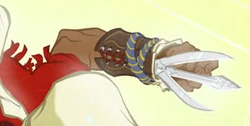
Arbaaz Mir's three-pronged Trident Blade
Like other mechanically modified Hidden Blades, the Trident Blade was a variation known to have been wielded by the Assassin Arbaaz Mir; of which the outer compartment could open out in a three-pronged fork, revealing another blade nestled within.[4]
Shock Blade

Concept art of the Shock Blade
The Shock Blade was a type of Hidden Blade used during the 21st century; replacing the traditional steel blade with two parallel blades which, upon penetration into the flesh of the target, generated an electrical arc, electrocuting the target and internally cauterizing the wound. By 2015, some Assassins were equipped with this new kind of weapon. Shaun Hastings notably used one to ambush and assassinate the high-ranking Templar Isabelle Ardant in London in 2015.[5]
Composite Blade
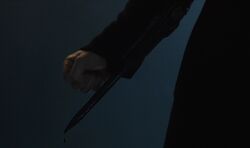
Callum's Hidden Blade
In order to infiltrate high-security areas, the Composite Blade was designed to be taken apart and put back together easily, with most of the separate components resembling everyday items, such as a belt buckle, a mobile phone case, a pen, and the blade itself. Callum Lynch and a small group of Assassins infiltrated the Templar Council of Elders' meeting at Holborn Hall in London, assembling the blade in a secluded area of the building; Callum used the Composite Blade to slit the throat of the Grand Master Alan Rikkin before reclaiming Aguilar's Apple of Eden.[17]
Razor-Wire Blade
In 2017; Saeko Mochizuki, the Mentor of the Japanese Brotherhood, sent a new gauntlet to Kiyoshi Takakura while he was on a mission abroad, the Razor-Wire Blade. Kiyoshi used his new gauntlet in Spain, against two Instruments who were holding him, severing their limbs.[31]
Replicas
- "The assassin leaps! As he lands upon the senator, a weapon protrudes from his wrist. Pierces his victim's neck!"
- ―Fiora Cavazza observing an Assassin's technique.[src]
In their study of the Assassins' methods and weaponry, several members of the Templar Order created their own variations of the Hidden Blade, though the mechanism and appearance often differed.[15] Additionally, the practice was not exclusive to the Order, some existing instances have been taken into account.
Switchblade
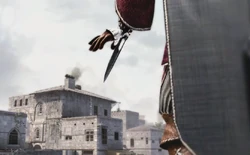
Il Lupo's switchblade
The first known instance of this was in the early 16th century when Fiora Cavazza and Baltasar de Silva tailed the Assassins of Rome in order to take note of their techniques. They eventually trained Il Lupo in the Assassins' ways and equipped him with a switchblade; a Hidden Blade variation that split into two parts, folding forward only when in use.[15] Lia de Russo also wore her own Hidden Blade, and though its mechanisms seemed to match that of the Assassins, it was worn on top of her forearm, rather than underneath.[16]
Corvix Blade
A replica of the Hidden Blade was designed by Demetrio il Silente based on blueprints stolen from Villa Auditore by the Crows. These replicas bore the symbol of a crow's head and were the preferred weapon of the group.[9]
Hand-crafted
While disguised as a slave in Chichen Itza, Aveline de Grandpré was forced to make replica Hidden Blades by scrounging up knives, belts, and wood. The end result was deemed crude but effective.[32]
Bi-jointed
In modern times, during the second stage of simulations hosted by the Animi Training Program of Abstergo Industries, every recruit was given access to a variation of the Hidden Blade. The virtual weapon was also worn under the left forearm, but its blade folded along two circular joints when not in use.[14]
Telescopic
As part of the console stage of Abstergo Entertainment's Animus technology, the Animi Avatars contained within could use another variation of the Hidden Blade, this time possessing a two-part telescopic function to the mechanism.[23]
Behind the scenes
- Design
Patrice Désilets, one of the creative directors for the Assassin's Creed series, stated that the addition of a second blade in Assassin's Creed II also had a lucid reason: "it's Assassin's Creed II, so there [were] two blades."
Assassin's Creed: Renaissance and early concept art for Assassin's Creed II show Ezio possessing three Hidden Blades; one on his right, and two on his left.
The original design of Ezio's second Hidden Blade in Assassin's Creed II is displayed as a brown glove. However, in-game it is replaced with a second bracer. This was reverted in Assassin's Creed: Brotherhood, however, where his second Hidden Blade included a glove until a bracer had been purchased.
Concept art for the "Shock Blade"; a modern version of the Hidden Blade, is shown in the Assassin's Creed Encyclopedia.
On his blog, Assassin's Creed concept artist Gilles Beloeil stated that the 21st century model of the Hidden Blade is much smaller, being 3.25 inches, yet still as effective as its older equivalents. It was shortened due to modern security systems, such as cameras.
Assassin's Creed: Brotherhood box art; E3 Trailer, and other official media including the opening cinematics for Assassin's Creed: Brotherhood and Assassin's Creed III depict Ezio with a secondary Hidden Blade bracer that is identical to his primary one even though in-game, no such second bracer exists. The same occurs with Ratonhnhaké:ton on the "Ignite the Revolution" poster and in the box art for Assassin's Creed III.
In early concept art for Assassin's Creed III; rope darts were integrated onto the Hidden Blade's bracer, envisioned as the "Chain Blade". This concept was later modified to be closer to reality, resulting in the "Chain Blade" being scrapped for a more reasonable alternative. This ultimately developed into a grappling hook for the Hidden Blade in Assassin's Creed: Syndicate used by the twins Evie and Jacob Frye. However, in Assassin's Creed Templars Volume 1: Black Cross, a similar weapon is used by the Black Cross Albert Bolden.
The second Hidden Blade is marginally longer than the primary one in Assassin's Creed: Brotherhood.
Early images of Assassin's Creed: Revelations show Ezio with a Hookblade on his left arm, rather than on his right. In these, the hook was incorporated directly into the blade, rather than as a separate function. The actual hook of the Hookblade resembles the head of an eagle, a bird frequently associated with the Assassin Order.
In various interviews and print media, Ubisoft Montreal stated that the Hookblade was intended to increase navigation speed by a factor of 30% in Revelations, in comparison to previous instalments of the Assassin's Creed series. The Hookblade was also considered for Assassin's Creed IV: Black Flag; but Darby McDevitt, the lead writer for Revelations and Black Flag, objected as he wanted to dispel the stereotype of hook-handed pirates.
Unlike the Hidden Gun and Poison Blade, the Hookblade supplemented Ezio's secondary Hidden Blade, rather than his primary one.
One concept art by Martin Deschambault for Assassin's Creed II shows two unimplemented Hidden Blade upgrades; a retracting arrow-shaped blade, and a retracting trident-ended blade for parrying weapons and disarming enemies. His art also shows two designs of the blade itself; feather-look, and normal blade with designed holes. Noticeable similarities with this concept and that of the Trident Blade aesthetically suggest that the design may have been used to create Arbaaz Mir's Hidden Blade.
In concept art for Assassin's Creed: Origins by Martin Deschambault, it was revealed that the original Hidden Blade from Persia in 500 BCE was originally worn above the right forearm rather than under the left wrist and did not require the sacrifice of the user's ring finger. This was later shown in Assassin's Creed: Odyssey with Darius wielding the first Hidden Blade above his right forearm whilst keeping all ten fingers.
Concept art for Bayek's Hidden Blade differs from its final in-game design.
- Mechanism
In the E3 teaser trailer of Assassin's Creed; as well as in certain concept art, Altaïr can be seen pushing a button to operate his Hidden Blade. In-game, however, no such button or other trigger mechanism existed.
In the Assassin's Creed: Renaissance and Assassin's Creed: Brotherhood novel, unleashing the Hidden Blade required the use of a button, via a certain muscle on the forearm being flexed. The same mechanism also triggered the Hidden Gun when Ezio's thumb is pushed to the left.
In an Assassin's Creed developer diary video, Jade Raymond spoke about the lack of Altaïr's ring finger and the Assassins' initiation ceremony.
The Hidden Blade is a crafted item in Assassin's Creed: Project Legacy. The materials for its construction are 2 Coils; 1 Iron, 1 Hide and 1 Box of Components. The latter in turn is crafted using 3 Gears; 3 Screws, 1 Chain and 2 Sprockets.
In Assassin's Creed: The Secret Crusade, the trigger mechanism is depicted as a ring worn around a pinky finger. Movement of that finger causes the blade to extend or retract.
Custom dictates that the Hidden Blade usually be worn on the left hand, as demonstrated by all Assassins who wield only one Hidden Blade.
The closest novel adaptation of the Hidden Blade to the in-game version appears in Assassin's Creed: Black Flag, wherein Edward Kenway stated he had activated the blade by the tensing of a muscle that comes from the upper arm as well as the forearm, and a simultaneous flick of the wrist. This is much unlike the ring-triggered or button mechanisms as mentioned in previous novels, thus more like the in-game Hidden Blade. However; this mechanism comes with the dangerous risk of accidentally activating the Hidden Blade while flicking the wrist unintentionally, which can result in the death of a person or the wielder themselves. This is acknowledged in Assassin's Creed: Underworld where, at one point, Ethan Frye rests his chin on his left hand while wearing a Hidden Blade, with the blade itself less than an inch from his throat.
Bayek's Hidden Blade may be different as his amputated ring finger has a leather cover which is connected to the Hidden Blade itself via a string (and the bracer via leather patching), which when pulled, extends or retracts the blade, matching the description as mentioned in The Secret Crusade. The string is also significantly long enough so as to not be pulled by accident.
- Miscellaneous
In Assassin's Creed, despite being equipped with a Hidden Blade some Assassins, such as Malik Al-Sayf, retained all fingers. This error was later corrected in Assassin's Creed: Revelations. Along with this, however, came another error. The Assassins retain amputated ring fingers even after Altaïr had changed the design of the blade so that amputation was no longer necessary.
In Assassin's Creed, the Hidden Blade is used in every major assassination. Even if an Assassin begins by attacking their target with a sword, they always finish them off with the Hidden Blade. Later games, however, changed so that the player can use any weapon they wish for major assassinations.
In Assassin's Creed: Bloodlines; if the PlayStation Portable was linked to Assassins Creed II, Altaïr's Hidden Blade can be upgraded to be able to block light and heavy attacks.
In Assassin's Creed: Altaïr's Chronicles, Altaïr can only use the Hidden Blade when standing directly behind an enemy for a low-profile assassination if that enemy is not a story-designated target. If the enemy is a specific assassination target; however, the player receives a prompt to high-profile assassinate from any position.
There is a glitch in the Assassin's Creed II mission "Practice What You Preach": if Ezio goes to the blacksmith and purchases the Leather Vambrace, instead of practising the new assassination techniques, he acquires the second Hidden Blade before Leonardo has even made it for him.
The Hidden Blade can be used in Valve's Team Fortress 2 by the Spy class under the name "Sharp Dresser". It was available for those who pre-ordered Assassin's Creed: Revelations on Steam before 2 December 2011.
In Assassin's Creed: Unity and Assassin's Creed: Syndicate, the Hidden Blade is restricted to stealth assassinations only; and is no longer available to use in open combat. That said, Jacob and Evie sometimes use the Hidden Blade in conjunction with their equipped weapon during kill animations.
In Assassin's Creed III and Assassin's Creed III: Liberation, some British, Continental, and Spanish troops, more specifically the scouts, can perform an animation that is similar to the hook and run which would temporarily disorientate Ratonhnhaké:ton and Aveline.
There are several cutscenes in which Ezio's Hookblade is not actually on his wrist. Examples include his conversation with Yusuf in "Setting Sail" and whenever he recruits an Assassin.
Various Templars such as Roi des Thunes or the Black Crosses have used the Templar pin as a discreet weapon for assassinations much like how the Assassins use Hidden Blades, meaning that the Templar pin could be considered the Hidden Blades' Templar counterpart.
In Assassin's Creed: Origins, when Aya gives the first Hidden Blade to Bayek, she identifies it as "a weapon of justice".
In the memory "End of the Snake" in Assassin's Creed: Origins, when Bayek assassinates Eudoros with the Hidden Blade, it always appears in its initial form, even if the player has upgraded the weapon.
Appearances
References

- ↑ Assassin's Creed: Origins - The Hidden Ones
- ↑ 2.0 2.1 2.2 Assassin's Creed: Embers
- ↑ Assassin's Creed III
- ↑ 4.0 4.1 4.2 4.3 4.4 Assassin's Creed: Brahman
- ↑ 5.0 5.1 5.2 5.3 Assassin's Creed: Syndicate
- ↑ 6.0 6.1 6.2 6.3 6.4 6.5 6.6 6.7 Assassin's Creed
- ↑ 7.00 7.01 7.02 7.03 7.04 7.05 7.06 7.07 7.08 7.09 7.10 7.11 7.12 7.13 7.14 7.15 7.16 Assassin's Creed II
- ↑ 8.0 8.1 8.2 8.3 8.4 8.5 8.6 8.7 8.8 8.9 Assassin's Creed: The Essential Guide
- ↑ 9.0 9.1 9.2 Assassin's Creed: Identity
- ↑ 10.0 10.1 Assassin's Creed: The Secret Crusade
- ↑ 11.0 11.1 Assassin's Creed: Renaissance
- ↑ Assassin's Creed: Black Flag
- ↑ 13.0 13.1 Cite error: Invalid
<ref>tag; no text was provided for refs namedOrigins - ↑ 14.00 14.01 14.02 14.03 14.04 14.05 14.06 14.07 14.08 14.09 14.10 14.11 Assassin's Creed: Revelations
- ↑ 15.0 15.1 15.2 15.3 15.4 15.5 Assassin's Creed: Project Legacy
- ↑ 16.0 16.1 16.2 16.3 Assassin's Creed: Brotherhood
- ↑ 17.0 17.1 17.2 Assassin's Creed: The Movie
- ↑ 18.0 18.1 Assassin's Creed: Lineage
- ↑ 19.0 19.1 19.2 Cite error: Invalid
<ref>tag; no text was provided for refs namedAC4 - ↑ 20.0 20.1 20.2 Assassin's Creed: Unity
- ↑ Cite error: Invalid
<ref>tag; no text was provided for refs namedLegacy - ↑ Assassin's Creed: Valhalla
- ↑ 23.0 23.1 23.2 23.3 23.4 23.5 Assassin's Creed III
- ↑ 24.0 24.1 Assassin's Creed: The Fall Issue #3
- ↑ Assassin's Creed: Initiates – Surveillance
- ↑ Assassin's Creed: Rogue
- ↑ Assassin's Creed: Forsaken
- ↑ Assassin's Creed: The Chain
- ↑ 29.0 29.1 Assassin's Creed: Unity novel
- ↑ Assassin's Creed Chronicles: China
- ↑ Assassin's Creed: Uprising
- ↑ Assassin's Creed III: Liberation
| ||||||||||||||||||||||||||||
| ||||||||||||||||||||||||||||
| ||||||||||||||||||||||||||||
| |||||||||||||||||||||||||||||||||||||
| ||||||||||||||||||||||||||||
| |||||||||||||||||||||||||||||||||||||
| |||||||||||||||||||||||||||||||||||||
| ||||||||||||||||||||||||||||||||||||||||
| ||||||||||||||||||||||||||||||||||
| ||||||||||||||||||||||||||||||||||||||||
| |||||||||||||||||||||||||||||||
| ||||||||||||||||||||||||||||||||||
| |||||||||||||||||||||||||||||||
| |||||||||||||||||||||||||||||||
| |||||||||||||||||||||||||||||||||||||
| ||||||||||||||||||||||||||||||||||||||||
| ||||||||||||||||||||||||||||||||||||||||||||||
| |||||||||||||||||||||||||||||||||||||||||||||||||||||||||


